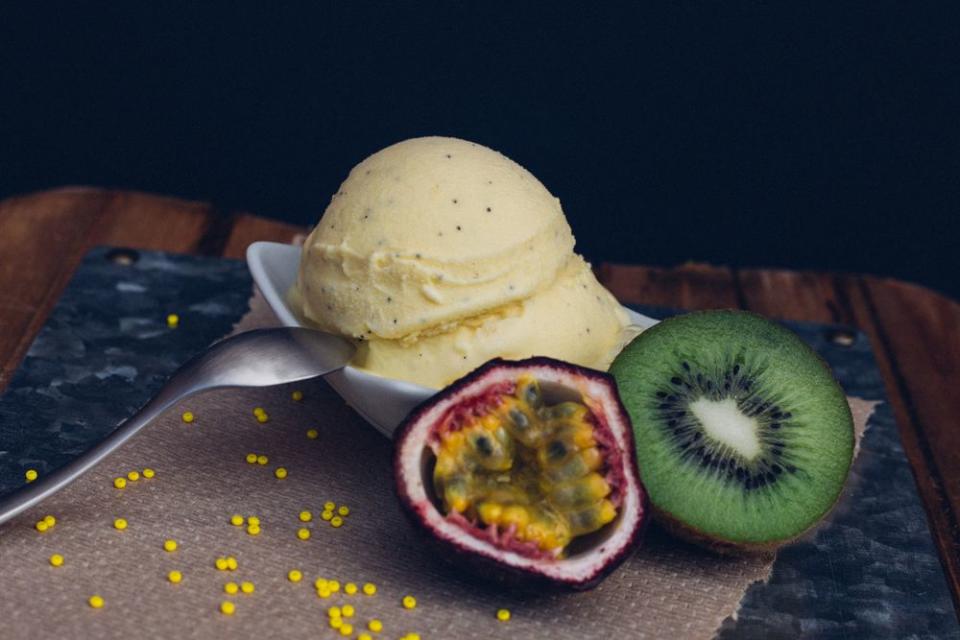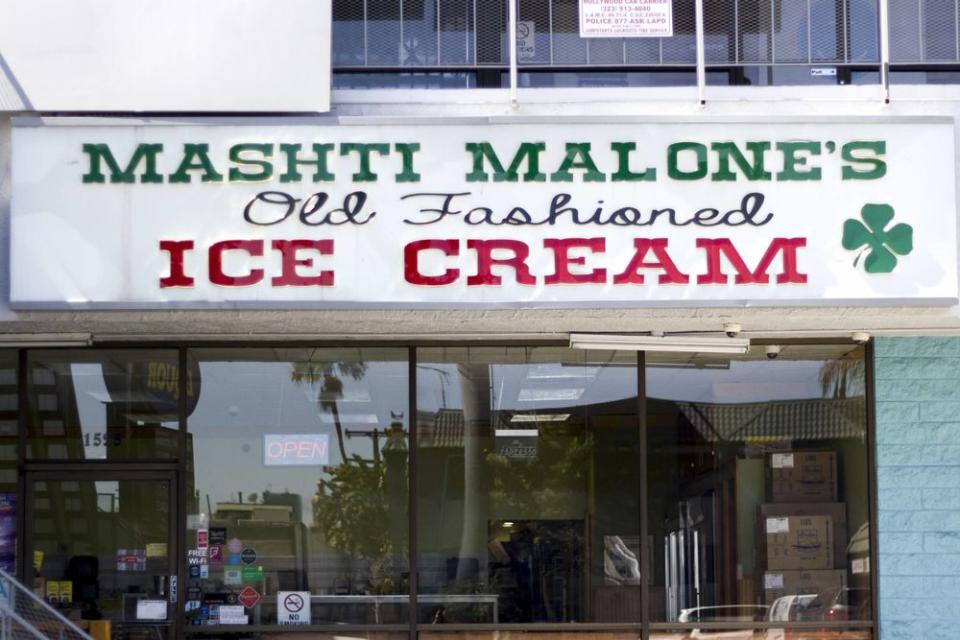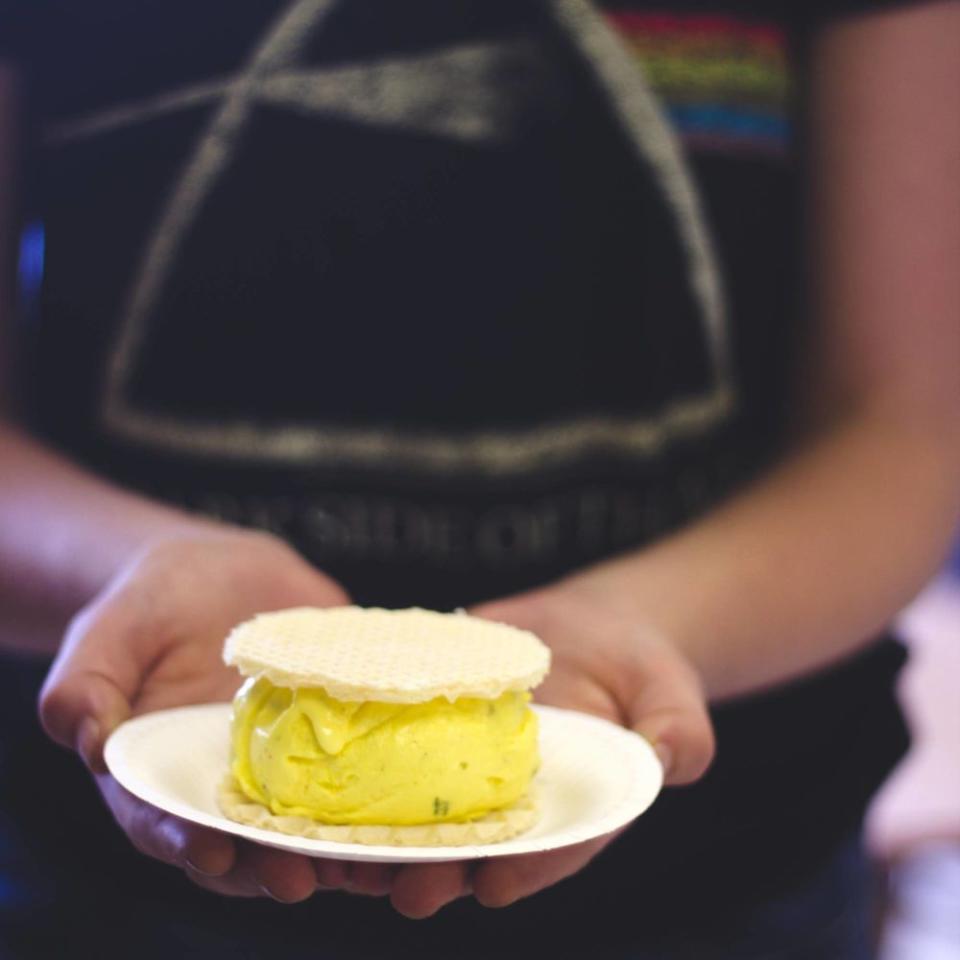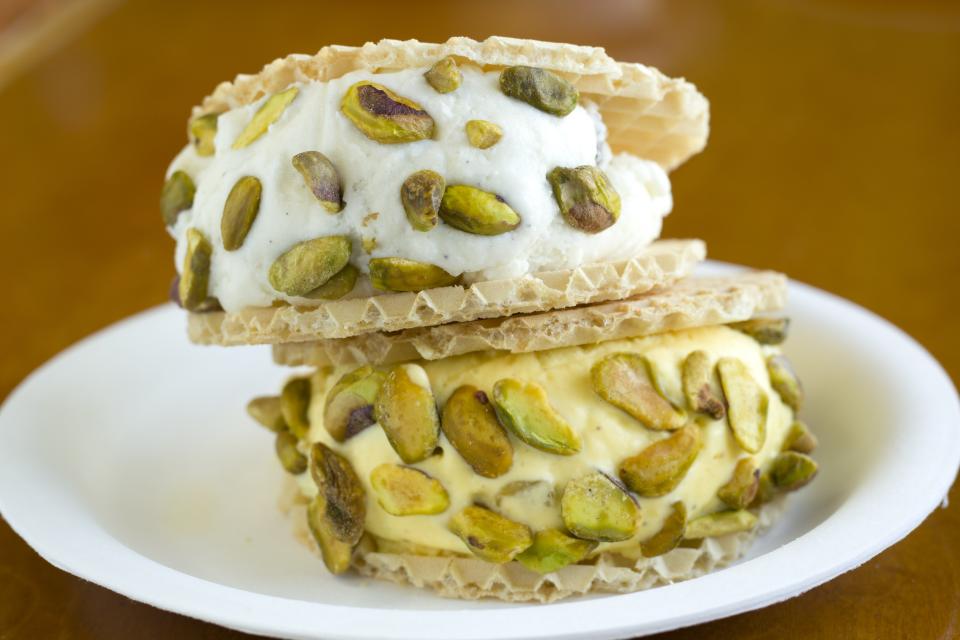How Persian Ice Cream Found Its Way to the Center of Los Angeles Food Culture
A few weeks ago, my brother-in-law purchased an ice cream machine on sale. Although he might be the human version of Bob the Builder and incredibly well-versed in just about any task he sets his mind to, my brother-in-law is no chef or ice cream maker. Why, then, purchase the tool? “To make akbar mashti, of course!” my husband said after I doubted his brother’s latest expenditure.
Immigrating to America in the mid-1970s in an effort to fulfill his American dream and avoid being persecuted for being Jewish—a notion that became a reality during the 1979 Iranian revolution—my brother-in-law still holds his country of origin dear, often reminiscing about the culture that has shaped his current outlook on life. Much of that love and devotion is connected to the foods he ate growing up. Although he gets to devour khoresht, tadeegh, and ghabalee—quintessential Persian foods made with ingredients easily found in specialty stores—authentic, perfectly prepared Iranian desserts are much more difficult to find. And when it comes to akbar mashti, traditional Persian ice cream, the feat becomes nearly impossible.
Enter Saffron & Rose and Mashti Malone’s Ice Cream, two specialty shops that brought the treat to Los Angeles. Given the large Persian population that calls L.A. home, it is no surprise that the two families helming the stores chose the California city as their home base. It is also no surprise that a sort of rivalry has arisen between the two businesses: half-hour away from each other, they cater to the same crowds, are masters at their craft, and each boast an origin story that adds that much more value to their already exotic products.
But this isn’t a story about industry rivalries, a battle of the ice creams on paper. This is a look at how a quintessential Iranian dish has not only shaped the childhood of an entire nation but has found its way to the center of an American city’s gastronomical culture despite staggering cultural differences among the two nations. What is it that makes bastani, Persian ice cream, so great?
Authentic Flavors
To start, a note on terminology: although bastani translates to ice cream in Farsi, many Tehran natives refer to it as akbar mashti, the name of one of the first men to serve the treat in Iran back in the day. Considered more of a slang term than a proper reference to the dessert, both Saffron & Rose and Mashti Malone’s are sellers of bastani.
“If you think about Persian ice cream, you’re going to be thinking about three iconic signature products,” explains Farbod Papen, who co-owns Saffron & Rose with his uncle Mike Kashani. The first is a saffron ice cream—a blend of rose water, milk, saffron, pistachios and chunks of cream—which he dubs the “vanilla ice cream of the United States” and is referred to by most Iranians as bastani sonnati (“authentic ice cream”).

A plainer variety of the “authentic stuff,” rose water ice cream is prepared without the saffron and pistachios and is called bastani sahde (“plain ice cream”) in Farsi.
Both shops also serve a treat that most closely resembles a sorbet. Originally prepared with shaved ice, lemon juice, and cherry, faloodeh now also includes vermicelli noodles, an update that Papen attributes to “the silk trade route, when products were brought from China and distributed through the Middle East and Europe.”
Ice Cream With Roots
Faloodeh’s history kicks off over 5,000 years ago, before the country benefited from electricity or running water. Iranians would build pyramid-like structures in the desert, huge mounds of sand with giant holes underneath them. During cold winter nights, wind would get trapped in the holes, bringing the temperature to below zero and effectively turning the area into a makeshift freezer. The structures were called yakh chol (yakh translates to “ice” and chol means “ditch”), a term that means “refrigerator” in today’s vernacular. In the summer, folks would grab blocks of ice from the ditches, take them back to the city, shave them and serve the cool treat with lemon juice and cherry.
The story of how faloodeh was born is one of the many gastronomical attributes that deepen the importance of Iranian food. Most popular American treats—from hamburgers to bagels to apple pies— trace their roots to other countries (Germany, Poland, and England, respectively) and, although indicative of America’s position as a hotbed of immigrants, they do little to add historical relevance to the local culinary scene. We’re a country of immigrants who surely appreciate our adopted home, but still cling tight to the places we’re from.
That loyalty is likely what has helped propel the popularity of bastani, at least in Los Angeles. Home to an estimated 300,000 to half-a-million Iranians, plenty of whom relocated to California in an effort to escape the 1979 revolution, certain parts of Los Angeles are so embedded in Persian culture as to sometimes be considered an extension of the Middle Eastern country itself. “Just a few years ago, the mayor of the city dubbed Westwood Boulevard, Persian Square,” says Papen, whose shop is in the area.

Home to ten Persian restaurants, six Persian grocery stores, antique stores, and rug shops, Persian Square is almost a replica of an Iranian village smack-dab in the middle of Los Angeles. Signs are pointing to an expansion: Mashti & Malone’s calls Hollywood home and Saffron & Rose is opening a second location in Orange County.
Although other smaller shops have attempted to take over the Persian ice cream market, Mashti & Malone’s and Saffron & Cream reign supreme. Both were opened in 1980 by immigrant Muslim families and sell à la carte and packaged treats distributed across restaurants and stores all over the country, the two shops have also surmounted similar challenges in their quest to reach success. Sure, catering to a number of immigrants might make for a good business model, but appealing to a wider range of customers that have yet to discover their love for Middle Eastern ice cream would help them carve out a more permanent space in the city’s landscape.
“In the 1980s and even the 1990s, it wasn’t that easy to convince a non-Persian or an American to try rose water,” says Mehdi Shirvani, who co-owns Mashti & Malone’s Ice Cream with his brother, Mashti Shirvani. “It always reminded them of air fresheners, soaps.” Papen echoes his sentiments: “When you think of rose water or cucumbers, you think of a spa, of facial treatments. You think of skin products and lotions and stuff and it’s because the Western world has associated those fragrances with beauty products—but that doesn’t necessarily mean that they won’t like it.”

Today, from speakeasies selling $18 drinks made with previously unheard of ingredients to restaurants specializing in non-American cuisines, venues all over America have been embracing the trend of the unfamiliar, selling products with flavor profiles reminiscent of distant lands, appealing to all kinds of palates.
“We have been using these ingredients in our foods for centuries,” says Papen. “Generations of Middle Easterners have been incorporating these in things that they eat and it’s almost like a shock factor to a lot of non-Middle Eastern people when they try this.” But that shock has clearly paid off, catapulting Persian ice cream to the top of an American city’s foodie offerings.
More must-read stories from Fortune:
—Foraging for ice cream with West Coast wunderkind Salt & Straw
—Toronto is home to a thriving Syrian food scene
—Acclaimed chef Thomas Keller on fine dining and eating ‘local’
—The Dolomites: Where Italian cuisine and adventure reach new heights
Follow Fortune on Flipboard to stay up-to-date on the latest news and analysis.

 Yahoo Finance
Yahoo Finance 
